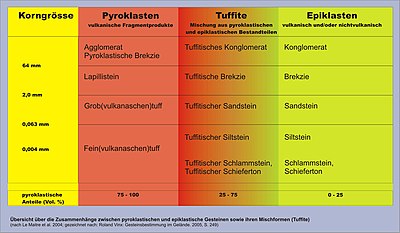Tuffite
A tuffite is a rock that consists of 25 to 75% of pyroclasts (volcanic ejecta); the remaining share is taken up by epiclasts ( clastic foreign material of volcanic and non-volcanic origin) and non-pyroclasts ( sediments ).
definition
In common usage, the term tuffite is often but incorrectly associated with a mixed sediment of fine-grained sediment and volcanic ash . According to another, outdated view, a tuffite is basically any volcanic ash deposited in the water ( subaquatic ), in contrast to the volcanic ash deposited on the ground ( subaeric ).
In the more recent literature, however, a tuffite is defined exclusively by the ratio of pyroclasts and non-pyroclasts, regardless of the grain size. A tuff must contain between 25 and 75 percent pyroclasts, the rest can consist of epiclasts or other non-pyroclastic components. For further subdivision according to the average grain size, the prefix tuffitic can also be used, which is placed in front of the corresponding rock (according to grain size):
- Tuffitic conglomerate (round components, diameter> 2 mm)
- Tuffitic breccia (angular components, diameter> 2 mm)
- Tuffite sandstone (diameter 2 mm to 0.063 mm)
- Tuffite siltstone (or siltstone) (diameter 0.063 mm to 0.002 mm)
- Tuffite claystone (or mudstone) (diameter <0.002 mm)
Tuffites are usually well stratified and sorted as a result of sedimentary transport , and they can also contain fossils .
Emergence
Two forms of formation can be distinguished in tuffites. The primary tuff is formed during a volcanic eruption and is particularly evident during Plinian eruptions . The pyroclasts (tephra) ejected from the volcano settle in the surrounding area and overload the water systems . This leads to a mixture of volcanic loose material and fluvial sediment . The secondary tuff is formed after a volcanic eruption, when the still unconsolidated pyroclastic deposits are removed and carried into a water system, where they mix with the sediment.
literature
- Roger Walter Le Maitre: Igneous rocks: IUGS classification and glossary; recommendations of the International Union of Geological Sciences, Subcommission on the Systematics of Igneous Rocks. 2nd ed., 236 pp., New York, Cambridge University Press 2002 ISBN 0-521-66215-X
